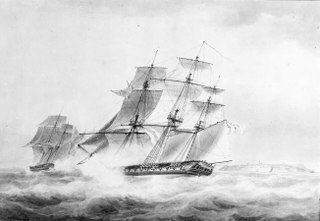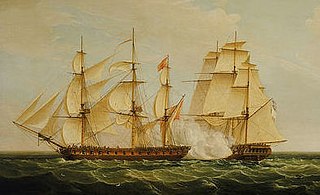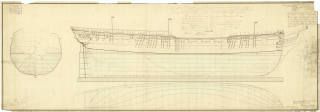
HMS Galatea was a fifth-rate 32-gun sailing frigate of the British Royal Navy that George Parsons built at Bursledon and launched in 1794. Before she was broken up in 1809 she captured numerous prizes and participated in a number of actions, first in the Channel and off Ireland (1794–1803), and then in the Caribbean (1802–1809), including one that earned her crew the Naval General Service Medal.

HMS Pegasus was a 28-gun Enterprise-class sixth rate. This frigate was launched in 1779 at Deptford and sold in 1816. Pegasus had a relatively uneventful career and is perhaps best known for the fact that her captain from 1786 to 1789 was Prince William Henry, the future King William IV. By 1811 Pegasus was a receiving ship at Chatham; she was sold in 1816.

HMS Arethusa was a 38-gun Minerva-class fifth-rate frigate of the Royal Navy built at Bristol in 1781. She served in three wars and made a number of notable captures before she was broken up in 1815.

HMS Anson was a ship of the Royal Navy, launched at Plymouth on 4 September 1781. Originally a 64-gun third rate ship of the line, she fought at the Battle of the Saintes.

HMS Phoenix was a 36-gun Perseverance-class fifth-rate frigate of the Royal Navy. The shipbuilder George Parsons built her at Bursledon and launched her on 15 July 1783. She served in the French Revolutionary and Napoleonic Wars and was instrumental in the events leading up to the battle of Trafalgar. Phoenix was involved in several single-ship actions, the most notable occurring on 10 August 1805 when she captured the French frigate Didon, which was more heavily armed than her. She was wrecked, without loss of life, off Smyrna in 1816.

The Battle of Tory Island was a naval action of the French Revolutionary Wars, fought on 12 October 1798 between French and British squadrons off the northwest coast of County Donegal, then in the Kingdom of Ireland. The last action of the Irish Rebellion of 1798, the Battle of Tory Island ended the final attempt by the French Navy to land substantial numbers of soldiers in Ireland during the war.
Coquille was a 40-gun frigate of the French Navy, lead ship of her class, and launched in 1794. The Royal Navy captured her in October 1798 and took her into service as HMS Coquille, but an accidental fire destroyed her in December 1798.

Pomone was a 40-gun frigate of the French Navy, launched in 1785. The British captured her off the Île de Batz in April 1794 and incorporated her into the Royal Navy. Pomone subsequently had a relatively brief but active career in the British Navy off the Atlantic and Mediterranean coasts of France before suffering sufficient damage from hitting a rock. Due to this, the ship was taken out of service and then broken up in 1803.

HMS Ethalion was a 38-gun Artois-class fifth-rate frigate of the Royal Navy. She was built by Joseph Graham of Harwich and launched on 14 March 1797. In her brief career before she was wrecked in 1799 on the French coast, she participated in a major battle and in the capture of two privateers and a rich prize.
Vice Admiral Sir John Chambers White, KCB was a prominent British Royal Navy officer of the early nineteenth century, who participated in a number of engagements during the Napoleonic Wars. He achieved most of his fame in the late 1790s as the commander of HMS Sylph, a small brig operating in Northern European waters. White was able to capture a number of equivalent French, Spanish and Dutch vessels and on one occasion was instrumental in the destruction of a much larger French frigate by a British squadron. In 1798 he was with the squadron that discovered the French invasion attempt on Ireland and acted as a messenger in the campaign to destroy the invasion force that ended at the Battle of Tory Island. He was later flag captain for Sir John Borlase Warren and participated at the action of 13 March 1806 and the destruction of the Regulus in 1814. After the war, White largely retired, but retained several shore appointments and rose to the rank of vice-admiral.
Admiral Sir Lawrence William Halsted GCB was an officer of the Royal Navy who served during the American War of Independence and the French Revolutionary and Napoleonic Wars.
HMS Drake was a 14-gun brig-sloop of the Royal Navy. She was bought from a commercial builder during the early years of the American War of Independence, and went on to support operations in the English Channel and the Caribbean. At one stage she assisted an attack on a French-held island, an expedition commanded by a young Horatio Nelson. Laid up for a time after the end of the American War of Independence, she returned to service shortly before the outbreak of the French Revolutionary Wars. Drake spent most of her time in Caribbean waters, until being declared unfit for service in 1800 and deleted from the navy lists.
Thomas Eyles was an officer of the Royal Navy who served during the French Revolutionary and Napoleonic Wars.

HMS Success was a 32-gun Amazon-class fifth-rate frigate of the British Royal Navy launched in 1781, which served during the American Revolutionary, French Revolutionary and Napoleonic Wars. The French captured her in the Mediterranean on 13 February 1801, but she was recaptured by the British on 2 September. She continued to serve in the Mediterranean until 1811, and in North America until hulked in 1814, then serving as a prison ship and powder hulk, before being broken up in 1820.

The action of 12 May 1796 was a minor naval engagement during the French Revolutionary Wars between a squadron of British Royal Navy frigates and a frigate and four smaller ships of the Batavian Navy. The British squadron had been detached on the previous day from the British North Sea fleet under Admiral Adam Duncan, which was cruising off the Batavian fleet anchorage at the Texel, while the Batavian squadron was returning to the Netherlands from the Norwegian coast where it had been sheltering since suffering defeat at the action of 22 August 1795 the previous year. As the Batavian squadron neared the Batavian coast, the British squadron under Captain Lawrence Halstead attacked.

HMS Pearl was a fifth-rate, 32-gun British Royal Navy frigate of the Niger-class. Launched at Chatham Dockyard in 1762, she served in British North America until January 1773, when she sailed to England for repairs. Returning to North America in March 1776, to fight in the American Revolutionary War, Pearl escorted the transports which landed troops in Kip's Bay that September. Much of the following year was spent on the Delaware River where she took part in the Battle of Red Bank in October. Towards the end of 1777, Pearl joined Vice-Admiral Richard Howe's fleet in Narragansett Bay and was still there when the French fleet arrived and began an attack on British positions. Both fleets were forced to retire due to bad weather and the action was inconclusive. Pearl was then despatched to keep an eye on the French fleet, which had been driven into Boston.

HMS Melpomene was a 38-gun frigate of the Royal Navy. Originally a French vessel, she was captured at Calvi on 10 August 1794 and first saw British service in the English Channel, where she helped to contain enemy privateering. In October 1798, she chased a French frigate squadron sent to find the French fleet under Jean-Baptiste-François Bompart, that was routed at the Battle of Tory Island and in August 1799, she joined Andrew Mitchell's squadron for the Anglo-Russian invasion of Holland.

HMS Triton was a 32-gun fifth-rate frigate of the Royal Navy designed by James Gambier and launched in 1796 at Deptford. Triton was an experimental ship and the only one built to that design; she was constructed out of fir due to wartime supply shortages of more traditional materials and had some unusual features such as no tumblehome. Her namesake was the Greek god Triton, a god of the sea. She was commissioned in June 1796 under Captain John Gore, with whom she would spend the majority of her active service, to serve in the Channel in the squadron of Sir John Warren.

HMS Artois was a fifth-rate Artois-class frigate of the Royal Navy, designed by Sir John Henslow and launched in 1794 at Rotherhithe as the lead ship of her class. She served for the majority of her career in the English Channel under the command of Edmund Nagle in the squadrons of Edward Pellew and John Borlase Warren, notably taking part in the action of 21 October 1794 where she captured the 44-gun frigate La Révolutionnaire almost singlehandedly. She participated in a number of other actions and events including the attempted invasion of France in 1795. Artois continued to serve actively on the coast of France in blockade and patrolling roles, taking a large number of ships as prizes, until she was wrecked with no loss of life off Île de Ré on 31 July 1797 while attempting to reconnoitre the harbour of La Rochelle.

HMS Caroline was a 36-gun fifth-rate Phoebe-class frigate of the Royal Navy. She was designed by Sir John Henslow and launched in 1795 at Rotherhithe by John Randall. Caroline was a lengthened copy of HMS Inconstant with improved speed but more instability. The frigate was commissioned in July 1795 under Captain William Luke to serve in the North Sea Fleet of Admiral Adam Duncan. Caroline spent less than a year in the North Sea before being transferred to the Lisbon Station. Here she was tasked to hunt down or interdict French shipping while protecting British merchant ships, with service taking her from off Lisbon to Cadiz and into the Mediterranean Sea. In 1799 the ship assisted in the tracking of the French fleet of Admiral Étienne Eustache Bruix, and in 1800 she participated in the blockade of Cadiz.


















